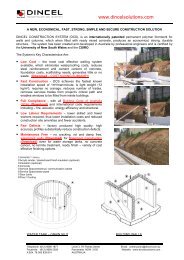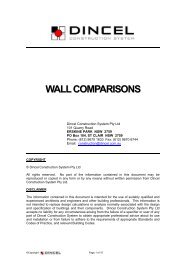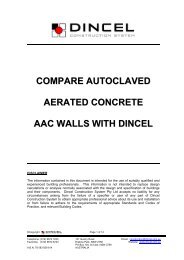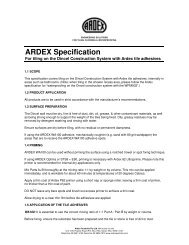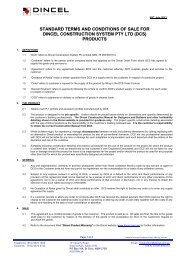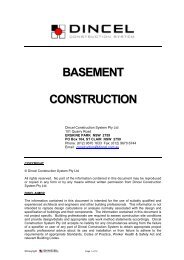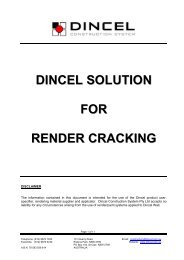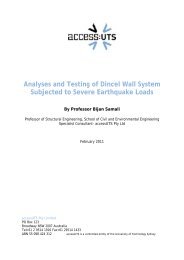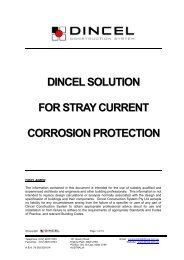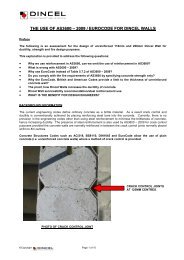Dincel-Wall Fire Assessment - Dincel Construction System
Dincel-Wall Fire Assessment - Dincel Construction System
Dincel-Wall Fire Assessment - Dincel Construction System
Create successful ePaper yourself
Turn your PDF publications into a flip-book with our unique Google optimized e-Paper software.
DINCEL WALL<br />
FIRE ASSESSMENT<br />
DISCLAIMER<br />
The information contained in this document is intended for the use of suitably qualified and<br />
experienced architects and engineers and other building professionals. This information is not<br />
intended to replace design calculations or analysis normally associated with the design and<br />
specification of buildings and their components. <strong>Dincel</strong> <strong>Construction</strong> <strong>System</strong> Pty Ltd accepts no<br />
liability for any circumstances arising from the failure of a specifier or user of any part of <strong>Dincel</strong><br />
<strong>Construction</strong> <strong>System</strong> to obtain appropriate professional advice about its use and installation or from<br />
failure to adhere to the requirements of appropriate Standards and Codes of Practice, and relevant<br />
Building Codes.<br />
Revision Date Amendment<br />
A May 2010 Added Non-Combustibility <strong>Assessment</strong> by CSIRO<br />
B June 2010 Added Hydro Carbon <strong>Fire</strong><br />
©Copyright Page 1 of 17<br />
Telephone: (612) 9670 1633 101 Quarry Road Email: construction@dincel.com.au<br />
Facsimile: (612) 9670 6744 Erskine Park, NSW 2759 Website: www.dincel.com.au<br />
PO Box 104, St Clair, NSW 2759<br />
A.B.N. 78 083 839 614<br />
AUSTRALIA
SUMMARY<br />
The fire performance of<br />
has been assessed by:<br />
1. <strong>Fire</strong> Resistance Levels<br />
The University of New South Wales’ Certificate and Report (Reference No: 5),<br />
CSIRO Certificate FSV1346 (Reference No: 6) for <strong>Fire</strong> Resistance Levels.<br />
The letter of assessment by CSIRO FCO-2674 (Reference No: 4) states that<br />
polymer web links of <strong>Dincel</strong>-Form when concrete filled will not burn or melt away to<br />
create holes when subjected to fire conditions.<br />
2. <strong>Fire</strong> Hazard Properties<br />
Attachments and Liners to the walls must comply with BCA – Specification C.1.10<br />
(Reference No: 3) for Flammability and Smoke issues. As shown in the attached<br />
CSIRO certificate, <strong>Dincel</strong> is a GROUP 1 material (i.e. no limitations for its use in<br />
any place without any protection). <strong>Dincel</strong>’s smoke criteria is 2.5 times better than<br />
what is allowed by the BCA.<br />
The abovementioned certificates clearly states that <strong>Dincel</strong>-Polymer has no<br />
limitations of its use for flammability and smoke generation.<br />
3. Non-Combustibility<br />
The BCA requires the use of non-combustible materials to limit the fire load,<br />
smoke and fire spread.<br />
The letter of assessment by CSIRO FCO-2800 (Reference No: 8) states that the<br />
<strong>Dincel</strong>-Polymer is the equivalent of the deemed to non-combustible<br />
materials in Clause C1.12 of the BCA-2010.<br />
4. Bushfire Prone Areas<br />
The letter of assessment by CSIRO FCO-2755 (Reference No: 7) states that when<br />
<strong>Dincel</strong> Forms are filled with concrete it will comply with AS3959 – 2009 and<br />
allowed to be used in all bushfire conditions, including Bushfire Attack Level of<br />
BAL-FZ (i.e. the worst bushfire level).<br />
5. Hydro Carbon <strong>Fire</strong><br />
Existing and new building structures are built to satisfy the Building Code of<br />
Australia and the AS3600 Concrete Structures Code may not be suitable in<br />
resisting a hydro carbon fire depending on the type of concrete used and its<br />
moisture content. For more information (Download – <strong>Dincel</strong> Solution for Hydro<br />
Carbon <strong>Fire</strong>)<br />
Readers may refer to the following for further information.<br />
AND FIRE PERFORMANCE<br />
is a permanent polymer formwork for concrete filling.<br />
<strong>Dincel</strong>-Polymer forms DO NOT provide fire rating but the CONCRETE DOES.<br />
©Copyright Page 2 of 17
The concrete infill of<br />
provides the appropriate provisions. The<br />
requirement is, BCA-A 2.3 – <strong>Fire</strong> Resistance of Building Elements, Clause 2.d (ii) – <strong>Fire</strong><br />
Resistance Level (FRL) of a structural concrete wall to be determined in accordance<br />
with Australian Standard AS3600 for concrete structures as certified by (Reference No:<br />
5).<br />
There are three (3) components that are required to be identified for the FRP.<br />
• Insulation and Integrity – determined in accordance with AS3600 or a <strong>Fire</strong><br />
Testing Laboratory.<br />
• Structural Adequacy – determined in accordance with AS3600 for walls subject<br />
to the “deemed to satisfy” condition or a <strong>Fire</strong> Testing Laboratory can determine<br />
this criterion only up to the limits of the testing facility (i.e. applied load, wall<br />
height).<br />
Refer (download) <strong>Dincel</strong> <strong>Wall</strong> Building Code of Australia Compliance, pages 2, 3<br />
and 4 for further explanation.<br />
complies with the Deemed-To-Satisfy condition of the Building Code<br />
of Australia in accordance with the certificate by the UNSW (Reference 5).<br />
The CSIRO Certificate (Reference No: 6) has been organised to validate that Reference<br />
No: 4 which is <strong>Dincel</strong>-Form’s web-link will not burn or melt away to create holes so that<br />
the fire resistance level of<br />
is not affected. The test result by CSIRO<br />
(Reference No: 6 – Appendix A) has revealed that the presence of high slump (i.e. w/c -<br />
water/cement ratio) plays important roles in the fire resistance level (FRL). The <strong>Dincel</strong><br />
test by CSIRO consisted of typical block mix which has w/c > 0.7. As a result, the<br />
following FRL levels are to be adopted.<br />
Concrete Slump > 110mm : FRL is 240/240/230 minutes<br />
Concrete Slump < 110mm : FRL is 240/240/240 minutes<br />
<strong>Dincel</strong> does not recommend the use of w/c > 0.5.<br />
The <strong>Dincel</strong>-Polymer formwork holds the wet concrete until it sets. If for some reason<br />
<strong>Dincel</strong>-Polymer is required to be removed or even burns during a fire event, the<br />
remaining core component is ordinary concrete which provides the required <strong>Fire</strong><br />
Resistance Level for structural adequacy/integrity/insulation. Therefore, the presence of<br />
<strong>Dincel</strong>-Polymer remaining at the face of the concrete wall can be considered as nothing<br />
more than a lining or wall cladding material.<br />
The Non-Combustibility of<br />
consists of concrete infill and permanent polymer formwork. The<br />
non-combustibility of concrete has never been questioned. The question that must be<br />
answered is: – If <strong>Dincel</strong>-Polymer is used without any protection (i.e. sprinklers<br />
and/or non-combustible materials such as plasterboard, fibre cement sheets, etc.), does<br />
the BCA prohibit or limit the use of<br />
as a building product? In<br />
other words, in accordance with Reference 1, BCA is looking for the non-combustibility<br />
conditions if the presence of <strong>Dincel</strong>-Polymer increases fire load, smoke and fire spread.<br />
©Copyright Page 3 of 17
The answer to this question is ‘NO’ in accordance with the CSIRO report FCO-<br />
2800 in this document (Reference No: 8).<br />
In addition to CSIRO’s confirmation for the non-combustibility issue of<br />
, DCS offers the following further explanation for the benefit of<br />
the reader:<br />
The behaviour of the building element in question under fire conditions is normally<br />
controlled by the use of non-combustible materials.<br />
The many materials listed in the BCA as deemed to be “non-combustible” fail when<br />
tested in accordance with non-combustibility test, AS1530.1 (Reference 1).<br />
Reference No: 1 states that the BCA appears to use non-combustible construction in<br />
several roles.<br />
(i)<br />
The non-combustibility used to limit the potential fire load. The noncombustibility<br />
of <strong>Dincel</strong>-Polymer is not used to provide an appropriate fire<br />
resistance level. The concrete infill of<br />
provides the fire<br />
resistance level of a minimum four (4) hours as shown above.<br />
Reference No: 2 classifies the “Degree of Combustibility” as shown in the following<br />
table:<br />
©Copyright Page 4 of 17
A SUGGESTED CLASSIFICATION SCHEME FOR “DEGREES OF COMBUSTIBILITY”<br />
USING HEAT RELEASE DATA FROM THE CONE CALORIMETER (а)<br />
(RICHARDSON AND BROOKS 1991)<br />
Category<br />
Peak heat release heat<br />
(kW/m 2 )<br />
Total heat release<br />
(MJ/m 2 )<br />
Examples<br />
1<br />
10 or less<br />
5 or less<br />
Mineral fibre insulation board<br />
2<br />
100 or less<br />
25 or less<br />
(Paper-faced) gypsum plaster<br />
3<br />
150 or less<br />
50 or less<br />
FR Plywood<br />
4<br />
300 or less<br />
100 or less<br />
White pine planks; red oak flooring<br />
5<br />
300 or less<br />
100 or less<br />
Expanded polystyrene (b)<br />
(а) Test duration 15 min; irradiance 50 kW/m 2<br />
(b) Presence/absence of fire retardants not stated<br />
BCA – 2007, Part C1 – <strong>Fire</strong> Resistance and Stability, Clause C 1.12 – Non-Combustible<br />
Materials provides the list of materials that can be used as non-combustible. The<br />
gypsum plaster of the above table is classified as a non-combustible material.<br />
RIGID POLYMER FACED CONCRETE (DINCEL) TESTING BY CSIRO<br />
Test Method<br />
Irradiance<br />
(kW/m 2 )<br />
Peak HRR<br />
(kW/m 2 )<br />
Total Heat<br />
Release<br />
(MJ/m 2 )<br />
AS/NZS 3837:1998 50 15.5 4.41<br />
ISO 5660 Part 1 and Part 2 50 32 3.87<br />
(ii)<br />
The comparison between <strong>Dincel</strong> testing results by CSIRO and the above table<br />
from Reference No: 2 qualifies <strong>Dincel</strong> polymer to be considered as noncombustible.<br />
The <strong>Dincel</strong>-Polymer heat release test results are much better than<br />
the gypsum plaster which is well known as a non-combustible material.<br />
The non-combustibility is used to provide a temporary barrier against smoke<br />
spread.<br />
The materials that do not ignite at a surface temperature of approximately 300°c<br />
are suitable for use as smoke barriers (Reference 1) in accordance with AS1530.5<br />
which is identical to ISO 5657, <strong>Fire</strong> Tests – Reaction to <strong>Fire</strong> Ignitability of Building<br />
Products.<br />
The well known rigid PVC behaviour is:<br />
<br />
<br />
Flash ignition temperature - 390°c (temperature resulting from the presence<br />
of flame) greater than 300°c.<br />
Self ignition temperature - 450°c (temperature when no flame is present)<br />
greater than 300°c.<br />
The tests conducted by CSIRO have also measured a smoke criteria of 90.5m 2 /kg<br />
which is significantly less than the smoke threshold allowed by BCA which is<br />
250m 2 /kg (specification C 1.10 – 3 c (ii)).<br />
©Copyright Page 5 of 17
(iii)<br />
Non-combustibility is used to prevent flame spread over surfaces. The BCA<br />
– Specification A 2.4 – C 1.10 – <strong>Fire</strong> Hazard Properties – <strong>Wall</strong>s and Ceilings<br />
controls flame spread and fire growth in the early stages of the fire, the purpose is<br />
the same as control of lining materials. <strong>Dincel</strong>-Polymer forms consisting of<br />
concrete filling have been tested by CSIRO and classified as a Group 1 material.<br />
This means that<br />
without any cover or protection has no<br />
limitation for its use for the purpose of flame spread.<br />
CONCLUSION<br />
The above references confirm the following use of<br />
additional protection:<br />
without any<br />
<br />
<br />
<br />
<br />
provides 240/240/240 min FRL (Reference Nos: 4, 5 and 6) for<br />
the 200mm wall and 90/90/90 min FRL for the 110mm wall.<br />
The smoke test readings of <strong>Dincel</strong>-Polymer by CSIRO is 2.5 times better than the<br />
allowable smoke limit specified by BCA (Specification 1.10 – 3 c (ii)). (Reference<br />
3).<br />
<strong>Dincel</strong>-Polymer does not contribute to spread of fire since it is classified as a<br />
Group 1 material by CSIRO in accordance with BCA (Specification C 1.10 – 3 c).<br />
(Reference 3).<br />
<strong>Dincel</strong>-polymer is the equivalent of the deemed to non-combustible materials of<br />
the BCA, Clause C1.12 (Reference 8).<br />
References<br />
(1) Non-Combustibility in the Building Code of Australia (BCA) Implications FOR A<br />
NEW GLOBAL STANDARD<br />
Jane Blackmore – <strong>Fire</strong> Science and Technology Laboratory (FSTL), CSIRO,<br />
Australia.<br />
(2) <strong>Fire</strong> Code Research Program – Project 2 – <strong>Fire</strong> Performance of Materials<br />
(Technical Report FCRC – TR 95-01) prepared by V.P. Dowling and C Caird<br />
Ramsay CSIRO Division of Building, <strong>Construction</strong> and Engineering.<br />
(3) CSIRO Certificate (HF07ANK4245 and No: 439) and Report Number FNK<br />
0065. The Certificate for the report is attached to this assessment. If required<br />
the full report can be provided.<br />
(4) CSIRO Letter of <strong>Assessment</strong> of FCO-2674 for fire performance.<br />
(5) Certificate and Report by the University of New South Wales Consulting<br />
Services. Download – Structural Engineering Design Certification<br />
(6) Certificate of Test by CSIRO, Report No: FSV1346 and Appendix 5. (Refer<br />
attached document to this assessment).<br />
(7) CSIRO Letter of <strong>Assessment</strong> FCO-2755 for Bushfire Prone Areas.<br />
(8) CSIRO Letter of <strong>Assessment</strong> FCO-2800 for Non-Combustibility.<br />
©Copyright Page 6 of 17
REFERENCE NO: 3<br />
BCA SPECIFICATION C1.10 – Table 3<br />
WALL LINING MATERIALS (Material Groups Permitted)<br />
BCA Building Class <strong>Fire</strong> isolated Public corridors Specific areas Other areas<br />
exits<br />
<strong>Wall</strong> <strong>Wall</strong> <strong>Wall</strong> <strong>Wall</strong><br />
Class 2 & 3<br />
Excluding accommodation for the aged, people with disabilities and children<br />
Unsprinklered<br />
Sprinklered<br />
1<br />
1<br />
1, 2<br />
1, 2, 3<br />
1, 2, 3<br />
1, 2, 3<br />
1, 2, 3<br />
1, 2, 3<br />
Class 3 & 9a<br />
Accommodation for the aged, people with disabilities, children and Health-care buildings<br />
Unsprinklered<br />
Sprinklered<br />
1<br />
1<br />
1<br />
1, 2<br />
1, 2<br />
1, 2, 3<br />
1, 2, 3<br />
1, 2, 3<br />
Class 5, 6, 7, 8 & 9b Schools<br />
Unsprinklered<br />
Sprinklered<br />
1<br />
1<br />
1, 2<br />
1, 2, 3<br />
1, 2, 3<br />
1, 2, 3<br />
1, 2, 3<br />
1, 2, 3<br />
Class 9b – other than schools<br />
Unsprinklered<br />
Sprinklered<br />
1<br />
1<br />
1<br />
1, 2<br />
1, 2<br />
1, 2, 3<br />
1, 2, 3<br />
1, 2, 3<br />
Class 9c<br />
Sprinklered 1 1.2 1, 2, 3 1, 2, 3<br />
Notes:<br />
1. “Sprinklered” refers to a building fitted with a sprinkler system complying with Specification<br />
E1.5.<br />
2. “Specific areas” means within –<br />
(a) for Class 2 and 3 buildings, a sole-occupancy unit; and<br />
(b) for Class 5, open-plan offices with a minimum floor dimension/floor to ceiling height<br />
ratio > 5; and<br />
(c) for Class 6, shops with a minimum floor dimension/floor to ceiling height ratio > 5; and<br />
(d) for Class 9a health care buildings, patient care areas; and<br />
(e) for Class 9b theatres and hall etc., an auditorium; and<br />
(f) for Class 9b schools, a classroom; and<br />
(g) for Class 9c aged care buildings, resident use areas.<br />
CSIRO fire testing results in accordance with AS 3837 confirms that<br />
consists of Group 1 material and its Specific Extinction Area (SEA) is less than<br />
250m 2 /kg to comply with the requirements of the Building Code of Australia<br />
specification C1.10 Clause 4 <strong>Fire</strong> Hazard Properties for walls. (Refer to following<br />
certificate by CSIRO)<br />
Group 1 material Classification refers to compliance with the above table of<br />
Building Code of Australia that the product can be used in any location for any<br />
sprinklered or unsprinklered building and will meet the requirements of<br />
Specification C1.10 – Clause 4 of current BCA.<br />
The following certificate by CSIRO confirms that <strong>Dincel</strong> permanent formwork<br />
product material is classified as Group 1.<br />
©Copyright Page 7 of 17
REFERENCE NO: 3<br />
©Copyright Page 8 of 17
REFERENCE NO: 4<br />
©Copyright Page 9 of 17
REFERENCE NO: 4<br />
©Copyright Page 10 of 17
REFERENCE NO: 6<br />
©Copyright Page 11 of 17
REFERENCE NO: 6<br />
©Copyright Page 12 of 17
REFERENCE NO: 7<br />
©Copyright Page 13 of 17
REFERENCE NO: 7<br />
©Copyright Page 14 of 17
REFERENCE NO: 7<br />
©Copyright Page 15 of 17
REFERENCE NO: 8<br />
©Copyright Page 16 of 17
REFERENCE NO: 8<br />
©Copyright Page 17 of 17



